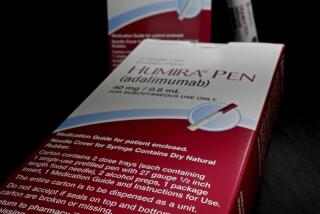Siemens Misses a Beat Developing Heart Aid : Health care: The Sylmar pacemaker firm is playing catch-up to Medtronic. But a recent accord may speed its quest.
- Share via
In the pacemaker business, there are two main providers to the U.S. market: industry leader Medtronic Inc. in Minneapolis, followed by Siemens Pacesetter Inc. in Sylmar. Together, they supply roughly 70% of the conventional pacemakers that bolster otherwise slow heartbeats.
Now Medtronic is getting lots of attention for its new device that does something different--it calms fast heartbeats. The company’s pacer-cardioverter-defibrillator (PCD), known more commonly as an implantable defibrillator, helps curb cardiac attacks caused by racing hearts. This type of heart attack strikes about 400,000 Americans each year.
Annual worldwide sales of such products are expected to more than triple, to $1 billion, by the decade’s end. (There are currently cruder versions of defibrillators on the market made by Eli Lilly & Co.’s Cardiac Pacemakers Inc. unit.) By comparison, current annual worldwide sales of conventional pacemakers total about $1.6 billion.
Medtronic has been selling its device in Europe and Canada for nearly two years. Last Thursday, it received U.S. Food and Drug Administration approval for domestic sales. Another company, Ventritex Inc., is closing in on FDA approval for a similar device.
So what does Siemens Pacesetter have to rival Medtronic’s product? It doesn’t, at least not yet.
Siemens Pacesetter concedes it’s at least a year behind Medtronic in bringing its device to American customers. The company is conducting trials of its defibrillator, the Siecure, on 55 patients in Europe. But it has yet to apply to the FDA to start human trials in the United States.
Given the huge resources of its parent company, the German conglomerate Siemens AG (annual sales $45 billion), Siemens Pacesetter’s slower pace in the burgeoning defibrillator market “is curious, isn’t it?” said Kurt H. Kruger, an analyst with the investment firm Hambrecht & Quist. “It’s very perplexing, and they stand to be missing a big opportunity.”
But Siemens Pacesetter, which had fiscal 1992 sales of $384 million, says it’s on track. “We will reach a position of parity and technological leadership,” said David Adinolfi, who oversees the company’s defibrillator program.
“We are at a competitive disadvantage in that the 18- to 24-month window will cause some problems,” Adinolfi said, referring to Medtronic’s head start. “We have approached it conservatively, but now that we have established a technology base, we are pursuing it aggressively.”
Even Medtronic believes Siemens Pacesetter will be a significant player in the market--eventually. “We have been firmly expecting them to take some aggressive steps in this field,” Medtronic spokesman Dick Reid said.
Medtronic’s PCD, which costs roughly $17,000, surpasses current technology by delivering electrical impulses to the heart that vary according to the heartbeat. It senses the heart’s pace, so its corrective impulses might be gentle, moderate or sharp.
Currently, Medtronic’s PCDs are implanted through conventional open-chest surgery. But Medtronic is awaiting FDA approval for a much less severe method. Here’s how it works:
A “pulse generator” weighing about seven ounces (or 10 times the weight of a typical pacemaker) is implanted just under the skin near the stomach. Connected to the generator are three thin “sensing” wires. A small incision is cut in the abdominal area, so that two of the wires can be sent through a vein and into the heart. The third wire is sent to a patch sewn under the skin near the heart.
After measuring the heart’s activity, the generator sends the electrical impulses via the patch to the chest, thereby changing the heart’s rhythm back to normal.
There had been industry speculation that Siemens Pacesetter, in its effort to catch up with Medtronic, might launch a takeover bid for a smaller American rival, such as Cardiac Pacemakers, Ventritex or Angeion Corp., which are developing similar devices.
Siemens Pacesetter partially confirmed that conjecture two weeks ago when it acquired exclusive licensing rights to an implantable defibrillator device being developed by Angeion, which, like Medtronic, is based in Minneapolis. The pact, among other things, would enable Angeion to sell its product through Siemens Pacesetter’s widespread marketing channels.
The deal shows that Siemens “is obviously trying to get a number of other irons in the defibrillator fire,” said Edward Mutsch, an analyst with Piper Jaffray Inc., a Minneapolis-based brokerage.
In exchange, Siemens Pacesetter paid $5 million for securities that are convertible into about 8% of Angeion’s common stock. Angeion could get an additional $3 million if it meets certain product-development goals.
But whether Siemens Pacesetter enters the field with its own defibrillator or someone else’s, Adinolfi said that history shows the company doesn’t have to be first to be successful.
In the early 1980s, he said, the first dual-chambered pacemakers--which deliver impulses to both the upper and lower chambers of the heart--were introduced by several companies. “Pacesetter was the last of the major players entering that segment,” he said.
“Yet within six years, Pacesetter assumed, and still enjoys, dominating that particular segment with 60% of the dual-chambered market,” Adinolfi said.
“To be first in the market has some advantages,” he added, “but being last also carries some advantages in that you learn from the mistakes that have been made.”
More to Read
Inside the business of entertainment
The Wide Shot brings you news, analysis and insights on everything from streaming wars to production — and what it all means for the future.
You may occasionally receive promotional content from the Los Angeles Times.









